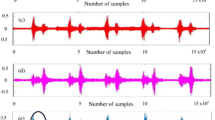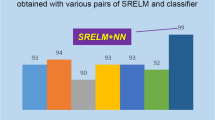Abstract
This paper focuses on identification of an effective pattern recognition scheme with the least number of time domain features for dexterous control of prosthetic hand to recognize the various finger movements from surface electromyogram (EMG) signals. Eight channels EMG from 8 able-bodied subjects for 15 individuals and combined finger activities have been considered in this work. In this work, an attempt has been made to recognize a number of classes with the least number of features. Therefore, EMG signals are pre-processed using dual tree complex wavelet transform to improve the discriminating capability of features and time domain features such as zero crossing, slope sign change, mean absolute value, and waveform length is extracted from the pre-processed data. The performance of extracted features is studied with different classifiers such as linear discriminant analysis, naive Bayes classifier, quadratic support vector machine and cubic support vector machine with and without feature selection algorithms. The feature selection has been studied using particle swarm optimization (PSO) and ant colony optimization (ACO) with different number of features to identify the effect of features. The results demonstrated that naive Bayes classifier with ant colony optimization shows an average classification accuracy of 88.89% with a response time of 0.058025 ms for recognizing the 15 different finger movements with 16 features with significant difference in accuracy compared to SVM classifier with feature selection for a significance level of 0.05. There is no significant difference in the accuracy, specificity and sensitivity of an SVM classifier with and without feature selection. But the processing time is significantly more than the LDA and NB classifier. The PSO and ACO results revealed that slope sign changes contribute to recognizing the activity. In PSO, mean absolute value has been found to be effective compared to waveform length, contradictory with ACO. Further, the zero crossings have been found to be not effective in classification of finger movements in both the methods.







Similar content being viewed by others
References
Gioioso G, Salvietti G, Malvezzi M, Prattichizzo D (2013) An object-based approach to map human hand synergies onto robotic hands with dissimilar kinematics. MIT Press, Cambridge
Shi WT, Lyu ZJ, Tang ST, Chia TL, Yang CY (2018) A Bionic hand controlled by hand gesture recognition based on surface EMG signals: a preliminary study. Biocybern Biomed Eng 38:126–135
Naik GR, Al-Ani A, Gobbo M, Nguyen HT (2017) Does heel height cause imbalance during sit-to-stand task: surface EMG perspective. Front Physiol 8:626
Naik GR, Selvan S, Nguyen HT (2015) Single channel EMG classification with ensemble-empirical-mode decomposition based ICA for diagnosing neuromuscular disorders. IEEE Trans Neural Syst Rehab Eng 24:734–743
Khokhar ZO, Xiao ZG, Menon C (2010) Surface EMG pattern recognition for real-time control of a wrist exoskeleton. Biomed Eng Online 41:1–17
Tenore F, Ramos A, Fahmy A, Acharya S, Etienne-Cummings R, Thakor NV (2007) Towards the control of individual fingers of a prosthetic hand using surface EMG signals. In: Proceedings of the 29th annual international conference of the IEEE EMBS
Naik GR, Nguyen HT (2015) Nonnegative matrix factorization for the identification of EMG finger movements: evaluation using matrix analysis. IEEE J Biomed Health Inform 19:478–485
Khushaba RN, Kodagoda S (2013) Electromyogram (EMG) feature reduction using mutual components analysis for multifunction prosthetic fingers control. In: Proceedings of IEEE 12th internatioanl conference on control automation robotics & vision
Montagnani F, Controzzi M, Cipriani C (2015) Is it finger or wrist dexterity that is missing in current hand prostheses. IEEE Trans Neural Syst Rehabil Eng 23:600–609
Chen X, Wang ZJ (2013) Pattern recognition of number gestures based on a wireless surface EMG system. Biomed Signal Process Control 8:184–192
Gu Y, Yang D, Huang Q, Yang W, Liu H (2018) Robust EMG pattern recognition in the presence of confounding factors: features, classifiers and adaptive learning. Expert Syst Appl 96:208–217
Al-Ani A, Koprinska I, Naik GR, Khushaba RN (2016) A Dynamic channel selection algorithm for the classification of EEG and EMG data. In: Proceedings of international joint conference on neural networks (IJCNN)
Phinyomark A, Hu H, Phukpattaranont P, Limsakul C (2012) Application of linear discriminant analysis in dimensionality reduction for hand motion classification. Meas Sci Rev 12:82–89
Peerdeman B, Boere D, Witteveen H, in’t Veld RH, Hermens H, Stramigioli S (2011) Myoelectric forearm prostheses: state of the art from a user-centered perspective. J Rehabil Res Dev 48:719–737
Farina D, Jiang N, Rehbaum H, Holobar A, Graimann B, Dietl H, Aszmann O (2014) The extraction of neural information from the surface EMG for the control of upper-limb prostheses: emerging avenues and challenges. IEEE Trans Neural Syst Rehabil Eng 22:797–809
Shin S, Tafreshi R, Langari R (2014) A Performance comparison of hand motion EMG classification. In: Middle East conference on biomedical engineering (MECBME)
Shenoy P, Miller KJ, Crawford B, Rao RPN (2008) Online electromyographic control of a robotic prosthesis. IEEE Trans Biomed Eng 55:1128–1135
Adewuyi AA, Hargrove LJ, Kuiken TA (2016) Evaluating EMG feature and classifier selection for application to partial-hand prosthesis control. Front Neurorobot 10:15
Geethanjali P, Ray KK (2011) Identification of motion from multi-channel EMG signals for control of prosthetic hand. Australas Phys Eng Sci Med 34:419–427
Farrell TR, Weir RF (2007) The optimal controller delay for myoelectric prostheses. IEEE Trans Neural Syst Rehabil Eng 15:111–118
Yang H, Guan C, Ang KK, Wang CC, Phua KS, Yu J (2012) Dynamic initiation and dual-tree complex wavelet feature-based classification of motor imagery of swallow EEG signals. In: Proceedings of IEEE world congress on computational intelligence
Subasi A (2012) Classification of EMG signals using combined features and soft computing techniques. Appl Soft Comput 12:2188–2198
Subasi A (2013) Classification of EMG signals using PSO optimized SVM for diagnosis of neuromuscular disorders. Comput Biol Med 43:576–586
Dorigo M, Stutzle T (2004) Ant colony optimization. MIT Press, Cambridge
Huang H, Xie HB, Guo JY, Chen HJ (2011) Ant colony optimization-based feature selection method for surface electromyography signals classification. Comput Biol Med 42:30–38
Negi S, Kumar Y, Mishra VM (2016) Feature extraction and classification for EMG signals using linear discriminant analysis. In: Proceedings of IEEE advances in computing, communication, & automation
Zhang H, Zhao Y, Yao F, Xu L, Shang P, Li G (2013) An adaptation strategy of using LDA classifier for EMG pattern recognition. In: 35th annual international conference of the IEEE EMBS. pp 4267–4270
Sahin U, Sahin F (2012) Pattern recognition with surface EMG signal based wavelet transformation. In: Proceedings of IEEE international conference on systems, man, and cybernetics
Alkan A, Günay M (2012) Identification of EMG signals using discriminant analysis and SVM classifier. Expert Syst Appl 39:44–47
Author information
Authors and Affiliations
Corresponding author
Ethics declarations
Conflict of interest
The authors of this paper declare no conflict of interest.
Ethical approval
The EMG data for the analysis is open source data [8], provided by Rami Khushaba.
Rights and permissions
About this article
Cite this article
Purushothaman, G., Vikas, R. Identification of a feature selection based pattern recognition scheme for finger movement recognition from multichannel EMG signals. Australas Phys Eng Sci Med 41, 549–559 (2018). https://doi.org/10.1007/s13246-018-0646-7
Received:
Accepted:
Published:
Issue Date:
DOI: https://doi.org/10.1007/s13246-018-0646-7




